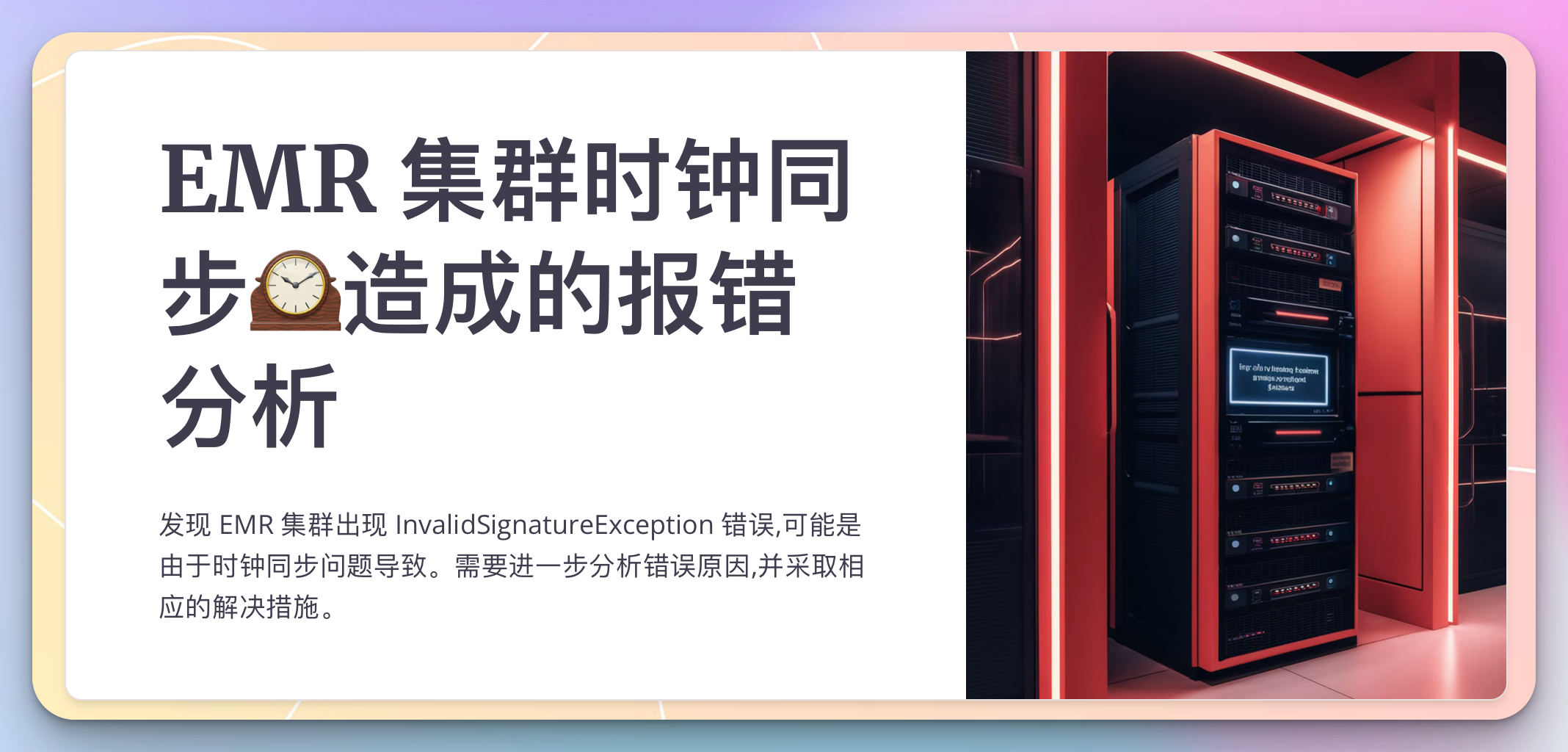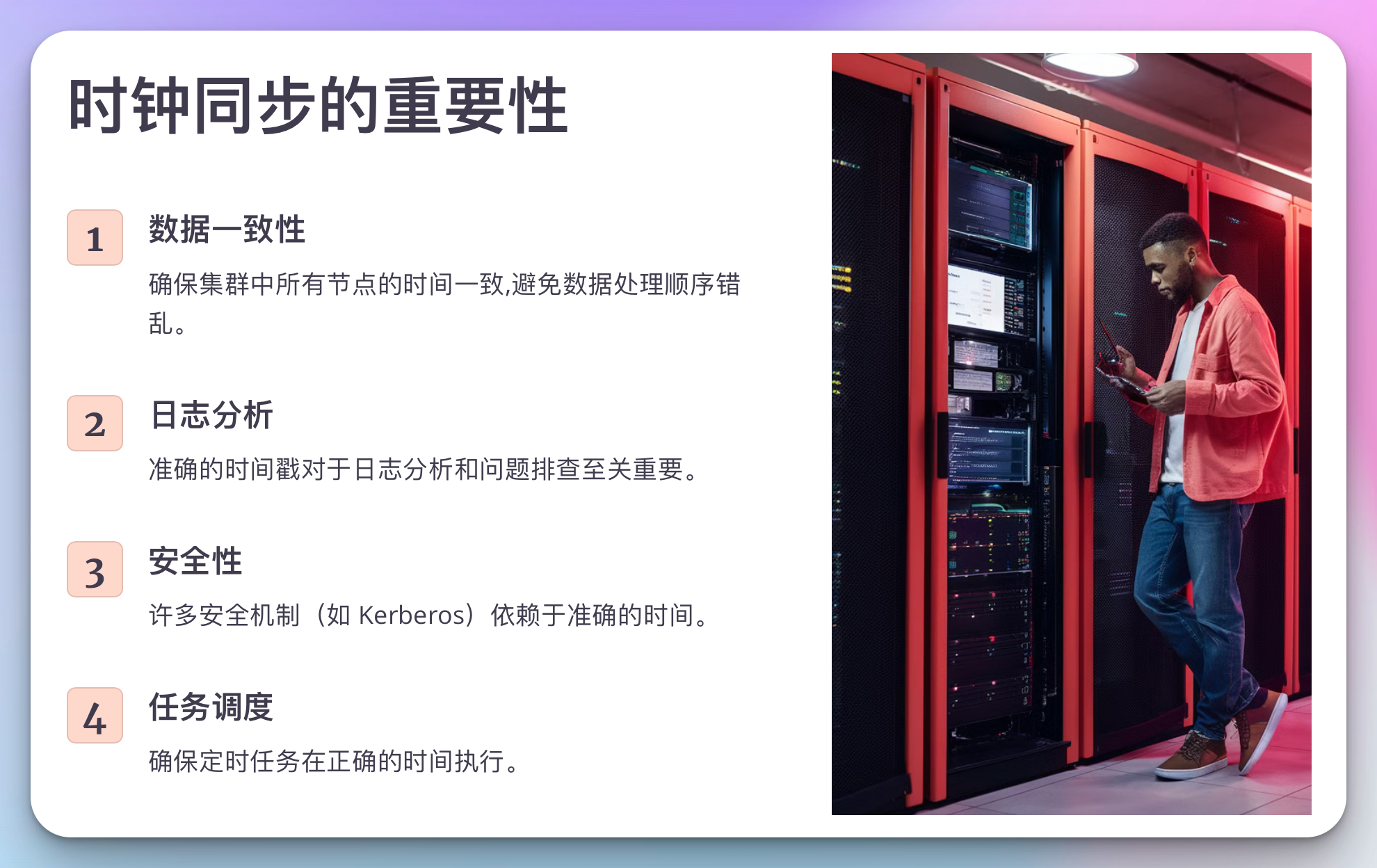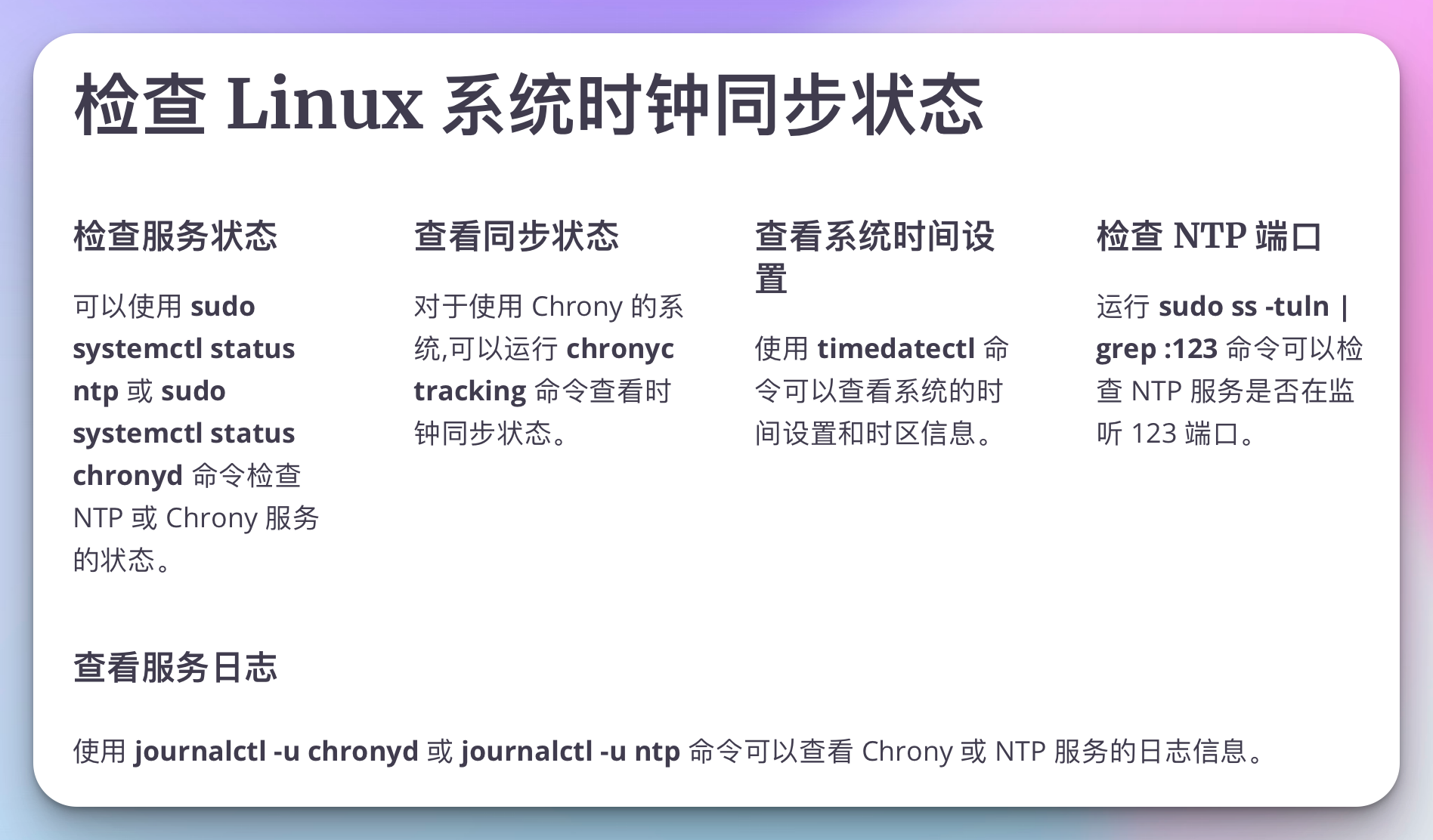
目录
- 1. 问题描述
- 2. 问题原因
- 3. 解决过程
- 4. 时钟同步的重要性
- 5. Linux 系统中的时钟同步方式
- 6. 检查 Linux 系统时钟同步状态
- 7. EMR 集群中的时钟同步配置
- 8. 时钟同步对大数据组件的影响
- 9. 监控和告警策略
- 10. 故障排除和最佳实践
- 11. 自动化时钟同步管理
- 12. 时钟同步与数据一致性
- 结语
1. 问题描述
在今天一次任务中,发现 EMR 集群报错:
An error occurred (InvalidSignatureException) when calling the ModifyInstanceGroups operation: Signature expired: 20240714T010336Z is now earlier than 20240714T010336Z (20240714T010836Z - 5 min.)
这个错误提示我可能存在时钟同步问题。
2. 问题原因

经过调查,我发现问题的根源在于:
- 集群的 HDFS NameNode 空间在前一天被写满。
- 这导致一些服务挂掉,包括负责时钟同步的服务。
- 由于时钟不同步,签名验证失败,从而无法执行 ModifyInstanceGroups 操作。
3. 解决过程

我通过以下步骤解决了这个问题:
-
首先,我检查了 NTP 服务的状态:
[hadoop@ip-10-xx-39-116 ~]$ sudo systemctl status ntp Unit ntp.service could not be found. -
发现 NTP 服务不存在,转而检查 chrony 服务:
[hadoop@ip-10-xx-39-116 ~]$ sudo systemctl status chronyd ● chronyd.service - NTP client/serverLoaded: loaded (/usr/lib/systemd/system/chronyd.service; enabled; vendor preset: enabled)Active: failed (Result: resources)Docs: man:chronyd(8)man:chrony.conf(5) -
发现 chronyd 服务失败,尝试重启该服务:
[hadoop@ip-10-33-39-116 ~]$ sudo systemctl restart chronyd -
重启后,我们再次检查服务状态:
[hadoop@ip-10-33-39-116 ~]$ sudo systemctl status chronyd ● chronyd.service - NTP client/serverLoaded: loaded (/usr/lib/systemd/system/chronyd.service; enabled; vendor preset: enabled)Active: active (running) since Sun 2024-07-14 01:14:11 UTC; 3s ago...
重启 chronyd 服务后,时钟同步问题得到解决。
4. 时钟同步的重要性

在大数据开发中,时钟同步至关重要,原因如下:
- 数据一致性:确保集群中所有节点的时间一致,避免数据处理顺序错乱。
- 日志分析:准确的时间戳对于日志分析和问题排查至关重要。
- 安全性:许多安全机制(如 Kerberos)依赖于准确的时间。
- 任务调度:确保定时任务在正确的时间执行。
- 分布式系统协调:很多分布式算法和协议依赖于精确的时间同步。
5. Linux 系统中的时钟同步方式

Linux 系统提供了多种时钟同步方式:
-
手动设置时间:
sudo date --set="2024-07-14 11:30:00" -
使用 NTP 服务:
安装 NTP:
sudo yum install ntp # CentOS/RHEL sudo apt-get install ntp # Debian/Ubuntu启动并启用 NTP 服务:
sudo systemctl start ntp sudo systemctl enable ntp -
使用 Chrony 服务:
安装 Chrony:
sudo yum install chrony # CentOS/RHEL sudo apt-get install chrony # Debian/Ubuntu启动并启用 Chrony 服务:
sudo systemctl start chronyd sudo systemctl enable chronyd -
配置时间服务器:
编辑
/etc/ntp.conf或/etc/chrony.conf,添加时间服务器:server 0.pool.ntp.org server 1.pool.ntp.org server 2.pool.ntp.org server 3.pool.ntp.org -
设置正确的时区:
sudo timedatectl set-timezone Your_Time_Zone
6. 检查 Linux 系统时钟同步状态

可以通过以下方法检查系统的时钟同步状态:
-
检查服务状态:
sudo systemctl status ntp # 或 sudo systemctl status chronyd -
查看同步状态:
对于 Chrony:
chronyc tracking -
查看系统时间设置:
timedatectl -
检查 NTP 端口:
sudo ss -tuln | grep :123 -
查看服务日志:
journalctl -u chronyd # 或 journalctl -u ntp
7. EMR 集群中的时钟同步配置

在 Amazon EMR 集群中,时钟同步通常是自动配置的,但了解其工作原理和如何进行手动调整很重要:
-
默认配置:EMR 默认使用 Chrony 进行时钟同步。
-
配置文件位置:通常位于
/etc/chrony.conf。 -
自定义配置:可以通过 EMR 的引导操作(Bootstrap Actions)来自定义时钟同步设置。
示例引导操作脚本:
#!/bin/bash
echo "server 169.254.169.123 prefer iburst minpoll 4 maxpoll 4" >> /etc/chrony.conf
sudo systemctl restart chronyd
在创建 EMR 集群时,可以添加这个脚本作为引导操作。
8. 时钟同步对大数据组件的影响

时钟同步问题可能对各种大数据组件产生不同程度的影响:
-
HDFS:
- NameNode 和 DataNode 之间的时钟差异可能导致数据块复制和删除操作异常。
- 文件修改时间可能不准确,影响数据管理和审计。
-
YARN:
- 资源调度可能受到影响,导致任务分配不均或超时。
- 容器生命周期管理可能出现问题。
-
HBase:
- 时间戳不一致可能导致数据版本混乱。
- Region 服务器之间的协调可能受到影响。
-
Hive:
- 分区修剪可能不准确,影响查询性能。
- 事务操作可能因时间戳问题而失败。
-
Spark:
- 任务调度和执行可能变得不可靠。
- Shuffle 操作可能因时间不一致而出错。
9. 监控和告警策略

为了及时发现和解决时钟同步问题,建议实施以下监控和告警策略:
-
NTP/Chrony 服务监控:
定期检查服务状态和同步精度。#!/bin/bash # 检查 Chrony 服务状态 chrony_status=$(systemctl is-active chronyd) if [ "$chrony_status" != "active" ]; thenecho "CRITICAL: Chrony service is not running"exit 2 fi# 检查时间偏移 offset=$(chronyc tracking | grep "Last offset" | awk '{print $4}') if (( $(echo "$offset > 0.1" | bc -l) )); thenecho "WARNING: Time offset is greater than 0.1 seconds"exit 1 fiecho "OK: Chrony service is running and time is in sync" exit 0 -
集群节点时间差异监控:
定期比较集群内各节点的时间差异。 -
日志分析:
设置自动化脚本,分析系统日志中与时间相关的错误。 -
性能指标监控:
监控可能受时钟影响的性能指标,如任务延迟、数据一致性错误等。 -
集成告警系统:
将时钟同步监控集成到现有的告警系统中,如 Prometheus + Grafana。
10. 故障排除和最佳实践

当遇到时钟同步问题时,可以遵循以下步骤进行故障排除:
- 检查网络连接:确保 NTP 服务器可达。
- 验证配置:检查 NTP/Chrony 配置是否正确。
- 检查系统负载:高负载可能影响时钟同步。
- 查看硬件时钟:使用
hwclock命令检查硬件时钟。 - 更新 NTP/Chrony:确保使用最新版本的时间同步软件。
最佳实践:
- 使用多个时间源以提高可靠性。
- 定期审核和更新时钟同步配置。
- 在关键操作前后进行时间同步检查。
- 在应用层面实现额外的时间验证机制。
11. 自动化时钟同步管理

为了更好地管理大规模集群的时钟同步,可以考虑实施自动化解决方案:
-
Ansible 自动化:
使用 Ansible playbook 统一管理集群的时钟同步配置。--- - name: Ensure time synchronizationhosts: allbecome: yestasks:- name: Install chronyyum:name: chronystate: present- name: Configure chronytemplate:src: chrony.conf.j2dest: /etc/chrony.confnotify: Restart chrony- name: Start and enable chronysystemd:name: chronydstate: startedenabled: yeshandlers:- name: Restart chronysystemd:name: chronydstate: restarted -
自动修复脚本:
开发自动检测和修复时钟同步问题的脚本,并通过 cron 任务定期运行。 -
容器化时钟同步:
对于容器化环境,考虑使用 sidecar 容器来管理时钟同步。
12. 时钟同步与数据一致性

在大数据系统中,时钟同步直接关系到数据一致性:
-
分布式事务:
- 在实现分布式事务时,精确的时钟同步对于保证全局一致性至关重要。
- 考虑使用逻辑时钟(如 Lamport 时钟)来补充物理时钟。
-
数据版本控制:
- 在实现多版本并发控制(MVCC)时,准确的时间戳是保证数据一致性的基础。
-
一致性模型:
- 在选择和实现一致性模型(如最终一致性、因果一致性)时,需要考虑时钟同步的精度。
-
数据复制和同步:
- 在跨数据中心的数据复制中,时钟同步对于维护数据的一致性和顺序至关重要。
示例:使用 Lamport 时钟实现分布式操作排序
public class LamportClock {private int counter;private final String nodeId;public LamportClock(String nodeId) {this.counter = 0;this.nodeId = nodeId;}public synchronized LamportTimestamp tick() {return new LamportTimestamp(++counter, nodeId);}public synchronized void update(LamportTimestamp other) {counter = Math.max(counter, other.getCounter()) + 1;}
}public class LamportTimestamp implements Comparable<LamportTimestamp> {private final int counter;private final String nodeId;// 构造函数、getter 和 setter@Overridepublic int compareTo(LamportTimestamp other) {int counterCompare = Integer.compare(this.counter, other.counter);if (counterCompare != 0) {return counterCompare;}return this.nodeId.compareTo(other.nodeId);}
}
结语

时钟同步是大数据系统中不可忽视的关键组件。
通过本文的深入探讨,我们不仅了解了如何解决 EMR 集群中的时钟同步问题,还认识到了时钟同步对整个大数据生态系统的重要影响。
作为大数据开发人员,我们需要:
- 时刻关注集群的时钟同步状态
- 实施有效的监控和告警机制
- 采用自动化工具进行管理
- 在应用设计中考虑时钟不同步的可能性
通过这些措施,我们可以构建更加可靠、一致和高性能的大数据系统,为数据驱动的决策提供坚实的基础。

T1 ⼩ 杨储蓄)





-顺序表)

【结构型-装饰器模式】)
SQL黑名单)








